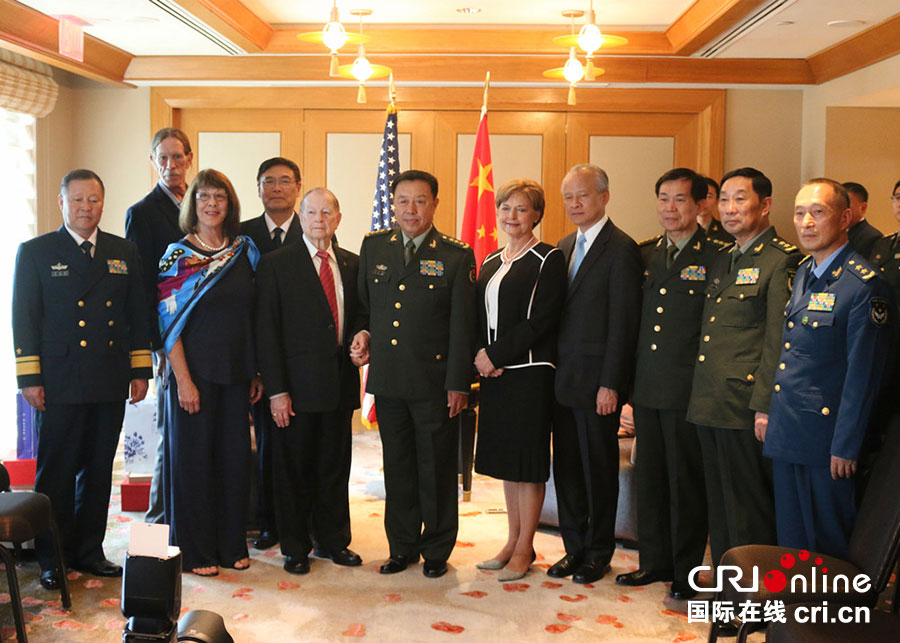Flying Tigers veteran Jay Vinyard
- By Guo Yiming
 0 Comment(s)
0 Comment(s) Print
Print E-mail China.org.cn, September 7, 2015
E-mail China.org.cn, September 7, 2015
Born in Arkansas, U.S. on Aug. 7, 1923, Jay Vinyard could never have known how tough a flying mission could be until he was summoned to join the Flying Tigers, an air unit supported covertly by the United States against Japan’s aggression in China.
 |
|
“Helping Chinese people fight against the Japanese aggression during World War Ⅱ was the most glorious thing in my life,” flying tiger veteran Jay Vinyard told Fan Changlong during Fan’s visit in Washington on July 12, 2015. |
In early 1944, the 20-year-old pilot, with a total of 850 hours of air time logged, was assigned to an unprecedented mission called “the Hump”, a high altitude military aerial supply route between the Assam Valley in northeastern India and Yunnan Province in southwestern China.
“I received a crash course on conducting a Curtiss C-46 Commando, a transport aircraft, before embarking on the tough journey in Asia,” Vinyard told the reporter during an interview in 2004. . “I was too young to have any lofty ideals about the trip, acting only out of obedience to superior arrangement.”
The death zone
The operation was the first sustained, long range, 24 hour, all weather, military aerial supply line in history.
Flying over the Hump proved to be an extremely hazardous undertaking for Allied flight crews.
The air route wound its way into the high mountains and deep gorges between northern Burma and western China, where violent turbulence, 125 to 200 mph (320 km/h) winds, icing, and inclement weather conditions were a regular occurrence.
A lack of suitable navigational equipment, radio beacons, and a scarcity of trained personnel continually affected airlift operations.
“‘Oh, my God’ was the most frequent utterance of my fellow crew encountering harsh situations during the flight over the Hump route,” said Vinyard. “Every mission could be my last chance on earth and a tiny little error may mean life and death.”
Never retreat
Faced with harsh circumstances, the flight crew tried to protect themselves and the civilians on the ground in case of a possible plane crash.
Looking back on those tough journeys, the 92-year-old veteran looks proud and excited. “Those were really harsh trips without on-ground navigation, and we could only conduct the aircraft based on experience,” Vinyard told the reporter. “And also, the engines were prone to various malfunctions and failures due to lack of maintenance.”
However, during his 87 missions, Vinyard never retreated even in the worst situations. “Helping Chinese people fight against the Japanese aggression during World War Ⅱwas the most glorious thing in my life,” said Vinyard.
“Although it was more than 70 years ago, memories of those days still haunt me every now and then,” Vinyard said, with emotions filling in his voice.
He has visited China five times after the war and the most recent time was his presence at the inauguration ceremony of the Guilin Flying Tigers Heritage Park in China’s Guangxi Zhuang Autonomous Region, on the site of Yangtang Airport where a squadron of American pilots was stationed.
Vinyard was invited by Fan Changlong, vice chairman of China’s Central Military Commission, to Beijing for the September 3rd military parade honoring the 70th anniversary of victory in the Chinese People’s War of Resistance against Japanese Aggression.
Lingering fears
Vinyard confessed that his most haunting memory of WWⅡwas the endless danger he faced every day. “It seemed that there would always be someone missing during every flight mission,” said the veteran with unforgotten trepidation.
Though Vinyard managed to cheat death several times, three of his best friends weren’t so lucky and were killed in accidents, with two killed in plane crashes along the Hump route and another killed on his trip from Pakistan to the United States after finishing the mission.
Those tragedies left a long-lasting memory on the American veteran who developed a shy and low-profile demeanor in the shadows of the war.
Terrible casualties
The Flying Tigers were highly successful in combat, bringing down almost 300 Japanese aircraft. However, the success of the operation did not come easily.
According to official records, the US army had provided 650,000 tons of aerial supply to China from April 1942 to August 1945. A total of 468 aircraft crashed along the Hump route with 1,314 crew members confirmed dead, 1,171 returning safely, and another 345 declared missing.






Go to Forum >>0 Comment(s)